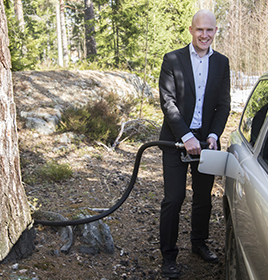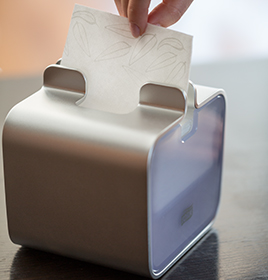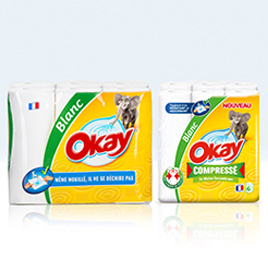Circular economy both a challenge and an opportunity
Contribute to a sustainable and circular society



Some examples of how SCA contributes to a circular economy (from the left): Manufacturing biofuel from by-products, Tork Xpressnap dispensers designed to reduce consumption and Okay Compressed, where innovative compression technology reduces climate impact by 8% over the life cycle of the household towel.
The circular economy is a business model that involves minimizing resource consumption and waste, and creating a closed loop or new ecosystem for reusing, recycling or composting. Work contributing to a sustainable and circular society requires new business solutions and innovations at the same time as new business opportunities are created. SCA works systematically using a holistic approach to achieve this long-term objective.
An increasing number of people are now sharing the planet’s resources. This requires society and businesses to abandon the linear economy, where products are manufactured and thrown away, and instead switch to a circular economy.
Since the beginning of the 1990s, SCA has worked with life cycle assessments, which involve a complete environmental analysis of a product’s value chain, from raw material, production and transport to use and waste management. SCA’s hygiene products have reduced their carbon footprint in recent years (see chapters Challenges become business opportunities and Economic value creation – People and nature innovations of the SCA Sustainability Report) and SCA continues to work with resource-efficient products and new services for customers. SCA has worked for some time with solutions for paper dispensers that reduce consumption by consumers. Tork Xpressnap is one example where SCA guarantees customers a 25% reduction in napkin consumption and Tork SmartOne is another, offering a reduction in toilet paper consumption of up to 40%.
SCA continuously works to improve resource efficiency, for example through the Energy Savings and Efficiency (ESAVE) program, which since 2010 has resulted in a 9% reduction in energy used per ton of product produced, equivalent to a reduction in energy consumption of 1.8 TWh. In 2016, 101 projects were implemented, resulting in a 0.9% reduction in energy use. SCA has also started a corresponding program for raw materials, MSAVE, which aims to optimize costs while minimizing environmental impact and waste from the raw materials. SCA has a goal to recycle and reuse 100% of its production waste and by-products from production. 65% is currently recycled.
SCA’s ambition is to design products for a circular economy so an increasing share can be efficiently reused or recycled. This is why a reduction in post-consumer waste is another focus area. SCA has, for example, developed a service where used paper towels from Tork are collected from customers and sent to a local SCA mill to produce new paper products (see also chapter Toward a circular society of the SCA Sustainability Report). SCA’s hygiene product portfolio primarily comprises disposable products and in order to contribute to a sustainable and circular society SCA is now working to find business models that include the efficient collection of used products and a technology that separates the different materials used in the products in a way that creates new, attractive, recycled materials.
In order to create new business models and innovations, SCA needs to find new partnerships and collaborations. In 2016, the company joined the Circular Economy 100 (CE100), an Ellen MacArthur Foundation program, which aims to accelerate the transition to a circular economy. Membership in CE100 will also strenghten SCA’s ability to contribute to the UN’s Sustainable Development Goals, in particular Goal 12, Sustainable Consumption and Production, and Goal 13, Climate Action.
Back to SCA's strategy
